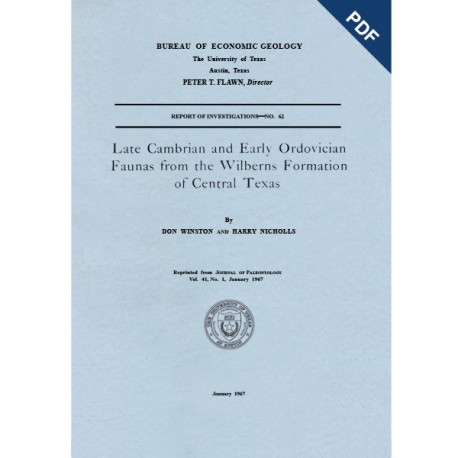Reports of Investigations
-
Books & Reports
- Reports of Investigations
- Guidebooks
- Udden Series
- Geological Circulars
- Down To Earth
- Atlases of Major Oil and Gas Reservoirs
- Texas Memorial Museum Publications
- Environmental Geologic Atlas of the Texas Coastal Zone
- Mineral Resource Circulars
- Other Reports
- Seminars and Workshops
- Handbooks
- Submerged Lands of Texas
- Symposia
- Annual Reports
- Open File Reports
-
Maps & Cross Sections
- Thematic Maps
- Miscellaneous Maps, Charts & Sections
- Geologic Atlas of Texas
- STATEMAP Project Maps
- Geologic Quadrangle Maps
- Cross Sections
- Highway Geology Map
- Energy and Mineral Resource Maps
- Shoreline Change and Other Posters
- Wilcox Group, East Texas, Geological / Hydrological Folios
- Bouguer Gravity Atlas of Texas
- River Basin Regional Studies
- Featured Maps
- Posters
- Teachers & the Public
-
Geological Society Publications
- Gulf Coast Association of Geological Societies
- Alabama Geological Society
- Austin Geological Society
- Corpus Christi Geological Society
- Houston Geological Society
- Lafayette Geological Society
- Mississippi Geological Society
- New Orleans Geological Society
- South Texas Geological Society
- GCS SEPM Publications
- Historic BEG & UT Series

Late Cambrian and Early Ordovician Faunas from Wilberns Formation of Central Texas. Digital Download
RI0062D
A free, digital version of this publication can be found on: Texas ScholarWorks
To purchase a print version (if available): RI0062
RI0062D. Late Cambrian and Early Ordovician Faunas from Wilberns Formation of Central Texas, by D. Winston and H. Nicholls. 31 p., 4 figs., 5 pls., 1967. doi.org/10.23867/RI0062D. Downloadable PDF.
To purchase this publication in book format, please order RI0062.
ABSTRACT
The San Saba Member of the Wilberns Formation of central Texas is mostly coarse-grained, trilobitic limestone that grades eastward to dolomite and contains sandstone intervals in its westernmost exposures. Faunas from the limestone place the middle part of the San Saba within the Trempealeauan Stage (Saukia zone) of the Upper Cambrian, but the uppermost part belongs to the Lower Ordovician. Three subzones within the Saukia. zone are described. In ascending order they are: the Saukiella junia subzone containing Bayfieldia, Briscoia, Corbinia, Euptychaspis, Eurekia, Saukia, Saukiella, Stenopilus, Triarthropsis, and Finkelnburgia; the Saukiella norwalkensis subzone containing Bayfieldia, Bowmania, Briscoia, Calvinella, ?Dikelocephalus, Eurekia, Euptychaspis, Heterocaryon, Idiomesus, Keithiella, Leiocoryphe, Macronoda, Plethometopus, Prosaukia, Saukiella, Stenopilus, Theodenisia, and Finkelnburgia; the Corbinia apopsis subzone containing Acheilops, Apatokephaloides, Corbinia, Eurekia, Idiomesus, Leiobienvillia, Leiocoryphe, Plethometopus, Theodenisia Triarthropsis, Apheoorthis, Finkelnburgia, Glyptotrophia, and Nanorthis. Trilobites of the Saukiella junia and Saukiella norwalkensis subzones are closely allied to those of the Trempealeauan of the upper Mississippi Valley, whereas the trilobites of the Corbinia apopsis subzone represent an influx of the Hungaia magnifica fauna.
The low Ordovician faunas are subdivided into two zones. The lower zone is named the Missisquoia zone and contains Highgatella, Homagnostus, Hystricurus, Missisquoia, Parabolinella, Symphysurina, Apheoorthis, Conotreta and Syntrophina. It correlates closely with a low Ordovician fauna from Vermont described by Shaw. The upper zone is the Symphysurina zone and contains Clelandia, Homagnostus, Hystricurus, Jujuyaspis, Symphysurina, Apheoorthis, and Syntrophina. It correlates most closely with the Symphysurina zone of Utah and Nevada.
New trilobite species are Acheilops masonensis, Bayfieldia simata, Bowmania sagitta, Briscoia llanoensis, Calvinella procera, Clelandia texana, Corbinia apopsis, Corbinia implumis, Euptychaspis jugalis, Homagnostus reductus, Keithiella patula, Leiobienvillia leonensis, Leiocoryphe halei, Missisquoia inflata, Missisquoia nasuta, Saukiella planata, and Symphysurina bubops.
Keywords: Cambrian, Ordovician, Wilberns Formation, Central Texas, faunas, Texas
Citation
Winston, D., and Nicholls, H., 1967, Late Cambrian and Early Ordovician Faunas from Wilberns Formation of Central Texas: The University of Texas at Austin, Bureau of Economic Geology, Report of Investigations No. 62, 31 p. doi.org/10.23867/RI0062D.
